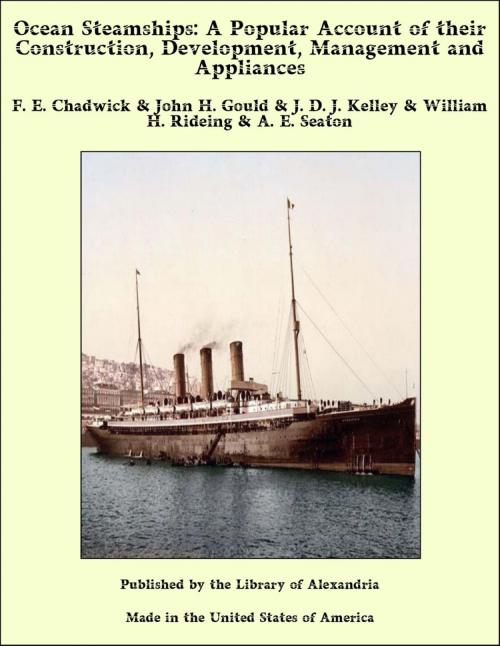Ocean Steamships: A Popular Account of their Construction, Development, Management and Appliances
Nonfiction, Religion & Spirituality, New Age, History, Fiction & Literature| Author: | F. E. Chadwick & John H. Gould & J. D. J. Kelley & William H. Rideing & A. E. Seaton | ISBN: | 9781465614599 |
| Publisher: | Library of Alexandria | Publication: | March 8, 2015 |
| Imprint: | Language: | English |
| Author: | F. E. Chadwick & John H. Gould & J. D. J. Kelley & William H. Rideing & A. E. Seaton |
| ISBN: | 9781465614599 |
| Publisher: | Library of Alexandria |
| Publication: | March 8, 2015 |
| Imprint: | |
| Language: | English |
IT is a wonderful fact in the swift expansion of mechanical knowledge and appliances of the last hundred years that while for unknown ages the wind was the only propelling force used for purposes of navigation, apart from the rude application of power through oars worked by men, the whole scheme of steam transport has grown, practically, to its present wonderful perfection within the lifetime of men yet living. Of course, the idea, as is that of all great inventions, was one of slow growth. It cropped up at various stages through the eighteenth century, and there are faint evidences of gropings in this direction in the latter part of the seventeenth; but these latter were not much more definite than the embodiment of the idea of the telegraph in Puck’s girdle round the earth, and the evidence that men really thought of propelling boats by steam is very meagre until we come to the pamphlet written by Jonathan Hulls, in 1737, in which he gave utterance to a very clear and distinct idea in the matter. It struggled through a very backward infancy of fifty years and more, certain memorable names appearing now and then to help it along, as that of Watt (without whose improvements in the steam-engine it must still have remained in swaddling-clothes), Fitch, De Jouffroy, Rumsey, Symington, and finally Fulton, who, however much he may have learned from his predecessors, has unquestionably the credit of putting afloat the first commercially successful steamboat. He is thus worthy of all the honor accorded him; much of it came too late, as he died at the comparatively early age of fifty, after passing through the harassments which seem naturally to lie in the path of the innovator. A graphic history of the wonderful changes wrought in this great factor of the world’s progress was set forth during the summer of 1886, at the International Exhibition at Liverpool, where, by model and drawing, the various steps were made more completely visible and tangible than, perhaps, ever before. True, the relics of the earlier phases of the steamship age, when its believers were but few and generally of small account, were sparse, but the exhibits of later models, from the date of the inception of transatlantic traffic, preparations for which were begun in earnest by laying down the steamship Great Western in 1836, were frequent enough, and the whole of the steps in the development of the means of ocean traffic from then till now were sufficiently well shown.
IT is a wonderful fact in the swift expansion of mechanical knowledge and appliances of the last hundred years that while for unknown ages the wind was the only propelling force used for purposes of navigation, apart from the rude application of power through oars worked by men, the whole scheme of steam transport has grown, practically, to its present wonderful perfection within the lifetime of men yet living. Of course, the idea, as is that of all great inventions, was one of slow growth. It cropped up at various stages through the eighteenth century, and there are faint evidences of gropings in this direction in the latter part of the seventeenth; but these latter were not much more definite than the embodiment of the idea of the telegraph in Puck’s girdle round the earth, and the evidence that men really thought of propelling boats by steam is very meagre until we come to the pamphlet written by Jonathan Hulls, in 1737, in which he gave utterance to a very clear and distinct idea in the matter. It struggled through a very backward infancy of fifty years and more, certain memorable names appearing now and then to help it along, as that of Watt (without whose improvements in the steam-engine it must still have remained in swaddling-clothes), Fitch, De Jouffroy, Rumsey, Symington, and finally Fulton, who, however much he may have learned from his predecessors, has unquestionably the credit of putting afloat the first commercially successful steamboat. He is thus worthy of all the honor accorded him; much of it came too late, as he died at the comparatively early age of fifty, after passing through the harassments which seem naturally to lie in the path of the innovator. A graphic history of the wonderful changes wrought in this great factor of the world’s progress was set forth during the summer of 1886, at the International Exhibition at Liverpool, where, by model and drawing, the various steps were made more completely visible and tangible than, perhaps, ever before. True, the relics of the earlier phases of the steamship age, when its believers were but few and generally of small account, were sparse, but the exhibits of later models, from the date of the inception of transatlantic traffic, preparations for which were begun in earnest by laying down the steamship Great Western in 1836, were frequent enough, and the whole of the steps in the development of the means of ocean traffic from then till now were sufficiently well shown.















